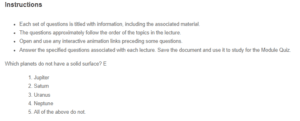Components of A Planet’s Surface
This discussion will focus on Question 12, “Which planets do not have a solid surface?” My choice was “All of the above do not.” Planets of the solar system are made of different surface materials. The materials vary depending on the planet. The first four planets closest to the sun comprise solid surfaces. Jupiter, Saturn, Uranus, and Neptune do not have a solid surface.
Jupiter and Saturn’s surfaces are made up of a gas giant that comprises hydrogen and helium. The Saturn ring is mainly made of water, ice particles, and rocky materials. Latitudinal effects on the ring material composition indicate the presence of two phases: gaseous and solid material (Miller et al., 2020). The gases get denser as the depth increases, causing it to form a metallic hydrogen. Further, the surfaces of Uranus and Neptune are made up of ice giants with a solid core. It has a thick atmosphere of gases like ammonia, methane, and water vapour. Neptune has 1.5 times more methane than Uranus, causing the dark blue tint, while Uranus is greenish blue (Michael et al., 2018).
Unlike Mercury, Venus, Earth, and Mars, which have solid surfaces such as rocks, Jupiter, Saturn, Uranus, and Neptune do not have a solid surface. Their surfaces are made of ice giants, that is, for Neptune and Uranus, whereas Jupiter and Saturn are made of gas giants. The Jovian planets are large and low-density planets.
Notably, the module provides knowledge about the planets using a structured format, including historical aspects of the planets, components of the planets, visual images, and comparative analysis. The module questions help to gauge the level of understanding of the planet.
References
Michael A. Seeds, Dana Backman. (2018). ASTRO 3: Introductory astronomy. Cengage learning.
Miller, K. E., Waite Jr., J. H., Perryman, R. S., Perry, M. E., Bouquet, A., Magee, B. A., & Glein, C. R. (2020). Cassini INMS constraints on the composition and latitudinal fractionation of Saturn ring rain material. Icarus, 339, 113595.
ORDER A PLAGIARISM-FREE PAPER HERE
We’ll write everything from scratch
Question

Components of a Planet’s Surface
Discuss one or more questions from Module 5 Questions [DOCX] and why you answered it the way you did.
Include other interesting remarks about the module
- Which planets do not have a solid surface? E
- Jupiter.
- Saturn
- Uranus
- Neptune
- All of the above do not.


